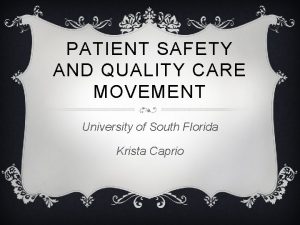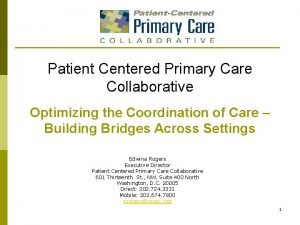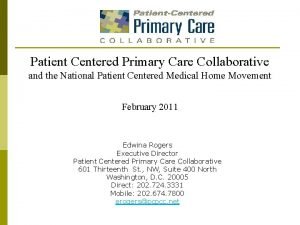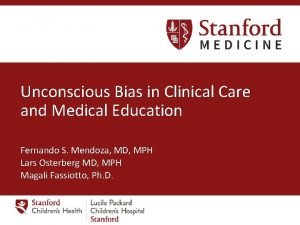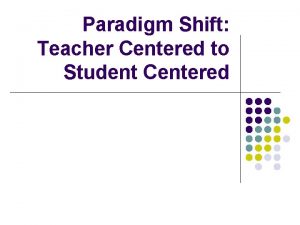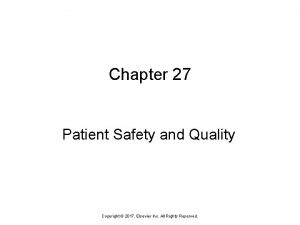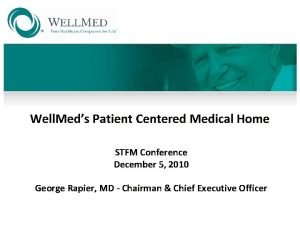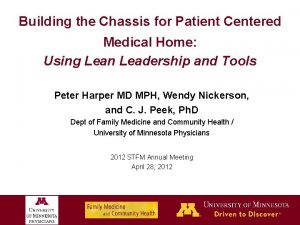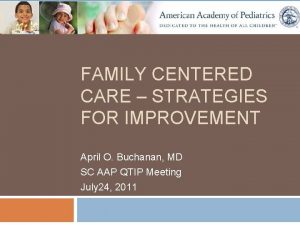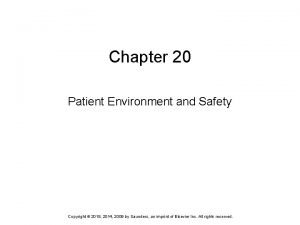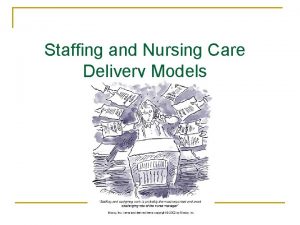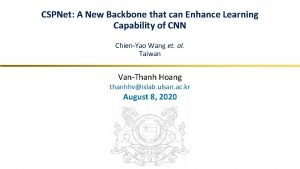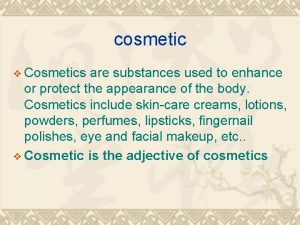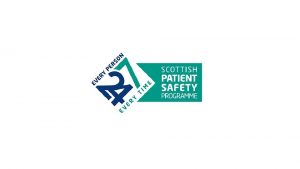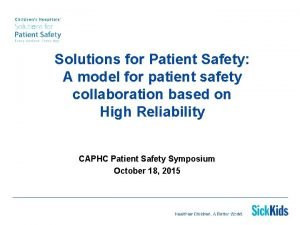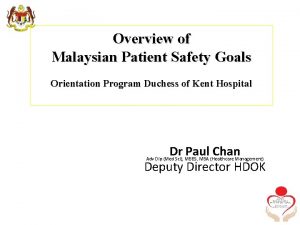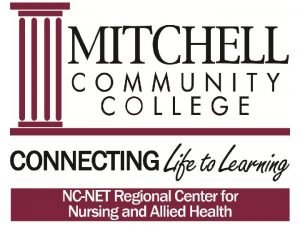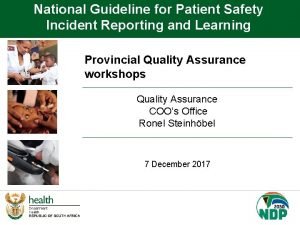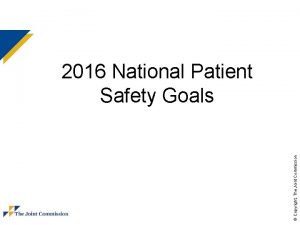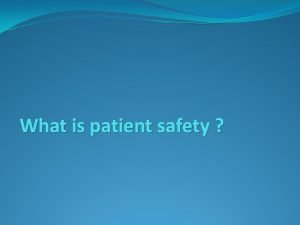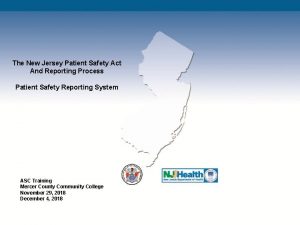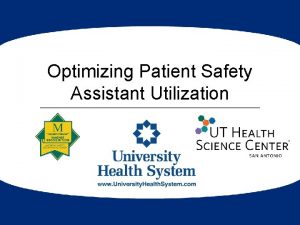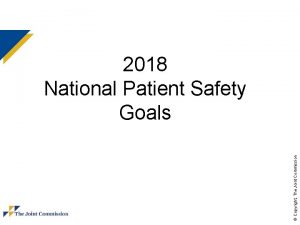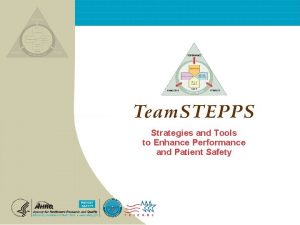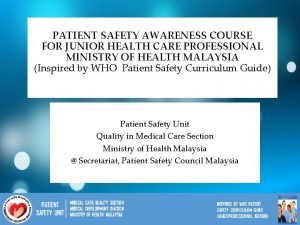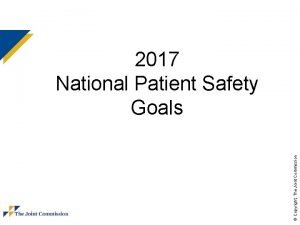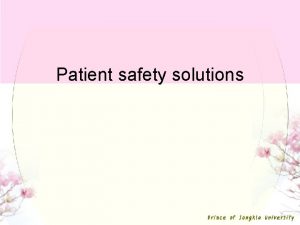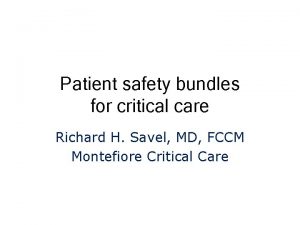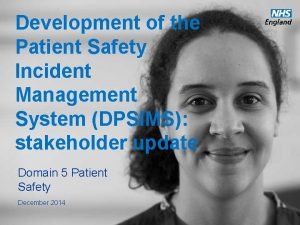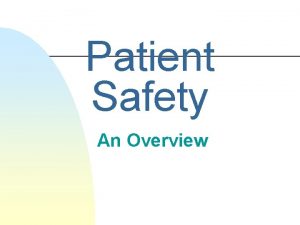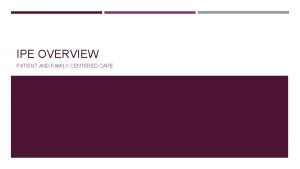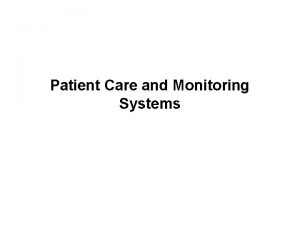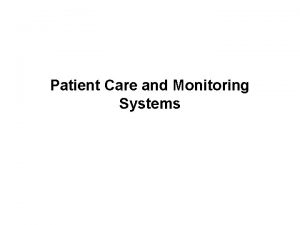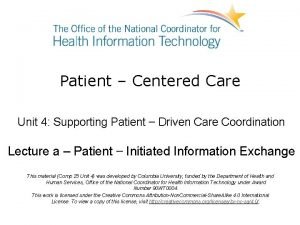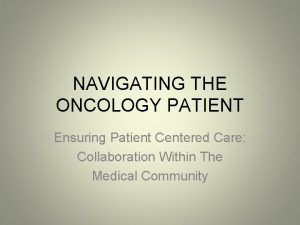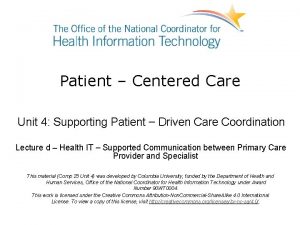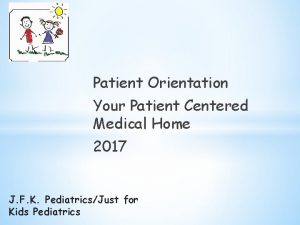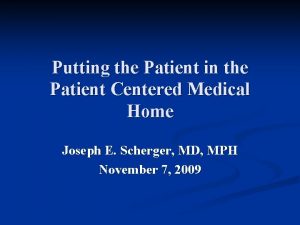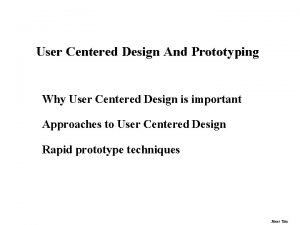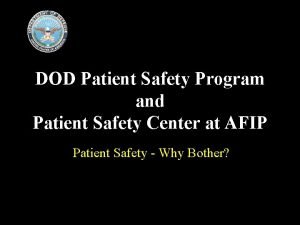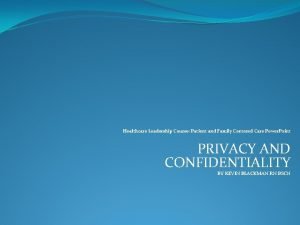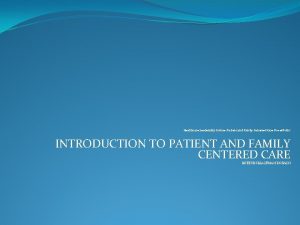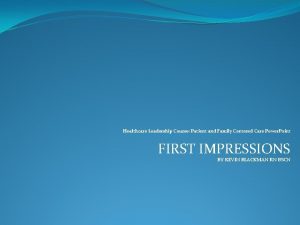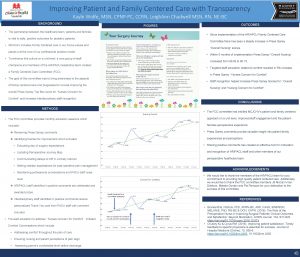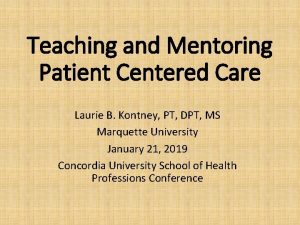Does Patient Centered Care Enhance Quality and Safety














































- Slides: 46

Does Patient Centered Care Enhance Quality and Safety? Human Factors, System Issues System Solutions 1 © 2010 Planetree, Inc.

Objectives of Presentation n n Provide concepts of how the Planetree philosophy can support system changes to enhance a culture of quality and safety Understand safety implications related to human performance Discuss how a patient centered approach can enhance patient and family involvement and patient safety Present outcome measures to demonstrate that a Planetree patient centered environment not only supports a culture of quality but also improves patient and employee satisfaction, and the bottom line 2

What Started Safety Awareness? n n 1999 - To Err is Human – IOM Study showed adverse events happen in 2. 9 to 3. 7 percent of hospitalizations Extrapolated over 33. 6 million admissions per year = 44, 000 -98, 000 deaths due to medical error per year Poor communication and a lack of teamwork was identified as a root cause of most safety problems 3

11 Years After the IOM “To Err is Human…” Report: What Has Changed? 4

Safety Hazard Probabilities (events per million opportunities) n n n Acquiring HIV from 1 unit of transfused blood 0. 7 All heads on 20 coin tosses 1. 0 Death of commercial airline passenger 2. 4 Death: general anesthesia 7. 5 Death: motor vehicle 187 Preventable hospital deaths 208 Orlikoff, J. Orlikoff and Associates, Inc. Chicago, IL. Jan. 2010 5

Cost of Medical Errors in U. S. n n n $17 billion costs associated with preventable errors (IOM, 1999) In the past, third party payers have paid regardless of outcome – changed as of 10/2008! Central Line associated bloodstream infections resulted in an average loss per case of $26, 839 in 2006 n Shannon et al, “Economics of Central-Line Associated Bloodstream Infections” American Journal of Medical Quality Supplement to Vol. 21, No. 6 Nov/Dec 2006 6

National Health Expenditures per Capita, 1980– 2007 7 Data: OECD Health Data 2009 (June 2009).

What are the “Other” Cost of Errors? n Errors may be career ending events n n n Trust issues and safety concerns on part of the consumers and payers Frustrated consumers n n Caregivers don’t intend to harm Silence often surrounds issues which may result in malpractice claims Sensational negative media coverage 8

News Headlines n SEPT. 2006: “HOSPITAL CHANGES PROCEDURES AFTER PREEMIE DEATHS”: n n NOV. 2007: “HOSPITAL REPEATS WRONG-SIDED BRAIN SURGERY”: n n Three preemies die after they receive adult doses of heparin at a hospital in Indianapolis “For the third time this year, doctors at Rhode Island Hospital have operated on the wrong side of a patient’s head – an action that has brought about censure from the state Department of Health and a $50, 000 fine. ” SEPT. 2010: “BABY DIES AT SEATTLE CHILDREN’S HOSPITAL AFTER OVERDOSE”: n …a hospital nurse gave her 10 times the proper dose of a medication, calcium chloride. Five days later, on Sept. 19, after suffering a brain hemorrhage, the baby died. 9

State of Colorado n Local TV news coverage on prevention of central line infections n n Discussed use of central line bundle Shortly thereafter, legislators in the State received a “slew” of e-mails from constituents demanding use of the central line bundle be made into law! 10

Put it in Perspective n n n 25% of US patients state they have experienced a medical error - 50% of those resulting in serious harm 42% of health care workers (HCW) state they have been personally involved in a medical error HCW’s state they fear becoming a patient n Seek the best MD – not the MD on call n Seek out high volume places for complicated surgeries n Seek out clinicians with at least 10 years experience (experienced but not burned out) n Avoid hospitalization in July – new interns, medical and nursing students (now proven by research) 11

What is Patient Safety n Freedom from accidental injury through: n n Systems and processes that decrease the likelihood of mistakes and Systems and processes that increase the likelihood of prompt identification and correction of errors and mistakes before they cause harm to a patient 12

What is High Quality Care? n IOM defines quality as: n n “The degree to which health care services for individuals and populations increase the likelihood of desired health outcomes and are consistent with current professional knowledge. ” High quality (evidence based) medicine allows for variation based on patient need, not on physician preferences (patient focused) 13

Evidence Based Care Bundles Hospital Infections are Preventable! FACT - 80, 000 CLABIs per year, cause about 28, 000 deaths In 103 ICUs in Michigan median CLABI rate per 1, 000 catheter days declined from 2. 7 to ZERO HOW? - It’s simple n Hand washing; n Full Barrier precautions; n Chlorhexidine use; n Avoid using the femoral site; n Removing unneeded catheters. n Provonost, et al. New England Journal of Medicine, Dec 28, 2006. 14

IHI- 5 Million Lives Saved Campaign Interventions targeted at harm: n Prevent Pressure Ulcers. . . n Reduce MDRO/MRSA Infections… n Prevent Harm from Medications. . . n Deliver Evidence-Based Care for CHF, AMI, Pneumonia… n Preventilator pneumonia n Prevent central line infections 15

16

“New” Reality of US Healthcare n n Evidence Based Care – Core Measures Medicare/insurance no longer pays for defined “never events” (10/08) n n National versus Local Standards Public reporting of quality data and safety events - transparency n n AHRQ measures reported to the public - 2010 Patient Centered Care 17

What is Patient Centered Care? Defined by the IOM: “…care that is respectful of and responsive to individual patient preferences, needs and values, and ensuring that patient values guide all clinical decisions. “ n New 2011 TJC Standards n 18

Opportunities for Improvement n Communication challenged n n Fragmented health care system Complex systems within hospitals Lack of standardization Hierarchies produce steep authority gradients n n Product of our success n n Advanced technology, rapid changes Necessary knowledge exceeds limits to human capacity n n Need better teamwork and communication > 6000 meds, >4000 treatments to choose from Professional craftsman model n No longer effective 19

Professional Craftsman Model “The Old Way” n With extensive training n n Eminence based training – not always evidence based Came “special privileges” n n n Full autonomy= full responsibility Creates a steep authority gradient Others have been there only to assist the MD in the past n n No recognized group decision making Results in the ‘Perfection Myth’ 20

Safety Implications Related to the ‘Perfection Myth’ n Safety depends on individuals - myth n n Error is due to carelessness – myth n n n Safety really depends on teamwork and communication More often a system or process error We have responded in the past with peer review, “be safer next time”, more education, 5 rights Punishment results in fewer errors - myth n System Improvements should be the focus 21

Dysfunctional Response to Error n Justification/rationalization n n Dishonesty with patients Cover-up/Non-reporting n n “Complications happen” Blame the patients Fear loss of reputation Healthcare workers look the other way when colleagues error 22

Who Is Watching Out For Patients? • 46% of physicians failed to report at least one serious medical error, even though 93% of them said they should report ALL significant medical errors they observe. • 45% said they did not report impaired or incompetent colleague physicians even though 96% said they should - ANNALS OF INTERNAL MEDICINE, DEC. 4, 2007 • 67% of physicians have not been involved in collaborative efforts to improve quality – COMMONWEALTH FUND NATIONAL SURVEY OF PHYSICIANS, 2007 23

A Different (Planetree) Approach Caring for the Caregivers n Leadership support for safety n Non-punitive reporting systems n Set up systems and processes for safety n Redundancy and double checks n n Standardization of processes n n n Medication administration vs. blood transfusion Checklists, pre-printed orders Find out about work-arounds Multidisciplinary quality committees 24

Caring for the Caregivers n Teamwork and communication support n n Robust reporting systems with feedback n n Enhanced communication models Errors recognized as system failures Mutual Support – I have your back Nurse Residency Programs Plan for and educate about limitations of human performance 25

Plan for the ‘Human Factor’ n n Humans make mistakes n Fatigue, interruptions, distractions, etc Overestimate abilities, underestimate limitations Goal is to keep inevitable mistakes from becoming consequential Reliable systems combined with effective communication is best practice 26

Human Limitations n n n Limited memory capacity– 5 to 7 pieces of information in short term memory Negative effects of stress –increased error rates, tunnel vision Negative influence of fatigue Limited ability to multitask Variable judgments and perceptions 27

Human Error is Inevitable Because: n n n Inherent human limitations Complex, unsafe systems Safety is often assumed, not assured We count on the expert individual “It won’t happen to me” or “it doesn’t happen here” attitude 28

Build on human factor skills n n Standardized (SBAR) communication Telephone order read-backs n n n Create redundancies, double checks Situational awareness n n Starbucks figured it out Time-outs, include the patient (patient centered) Decrease interruptions Debriefings after emergencies Patient Centered focus n n Bedside report including the patient/family Hourly rounding 29

A Different (Planetree) Approach n Patient centered approach n Knowledge about condition and choices n n Care partners n n Access to medical records Access to information – library/literature searches Health literacy Another “ear to hear” Patient and Family Advisory Council n Learn from their experiences 30

Planetree Patient Centered Care and Safety n “The patient is one of the most important allies in reducing medical errors. ” n n “Research indicates that when patients actively participate in their overall healthcare management, medical errors are reduced. ” n n ISMP Medication Safety Alert Oct. 2004 ISMP Medication Safety Alert Nov. 2004 Patients who have a clear understanding of their instructions, including how to take their medicines and when to make follow-up appointments, are 30 percent less likely to be readmitted or visit the emergency department n February 3, 2009, Annals of Internal Medicine 31

Planetree Criteria Promote Quality and Safety Planetree promotes a healing partnership between patients and caregivers. It’s a model of care that is committed to enhancing healthcare from the patient perspective. Empowers caregivers to do what is right for the patient. 360° data shows us that it is working! 32

Surgical Care Improvement Process Measures 33

Teamworks! D-T-B times improved! 34

VVH Culture of Safety Survey n Survey done July 2010 n n n Statistical improvements from 2008 Standardized AHRQ survey Designed to measure 4 major areas n n Overall perceptions of safety Overall patient safety grade Frequency of event reporting Number of events reported 35

36

Valley View Healthgrades™ Award n n Valley View Hospital is rated among the top 5% in patient satisfaction scores The Planetree patient centered philosophy actively supports programs to meet patient and family needs 37

“What Is the Likelihood of Recommending This Hospital? ” 38

VVH and Planetree Comparison 39 39

40

41

Turnover Rate: All Nurses On Payroll 42

Growth in Equity 43

Lessons learned n Safety and quality is not created by counting and control measures n n We thought competent, careful clinicians were sufficient to create safety n n We have learned that stories, complex dialogue, and teamwork create safety We have learned safety requires leadership, a supportive environment, a system focus, and solid teamwork Quality and patient safety are supported in a Planetree patient centered environment and the Planetree philosophy promotes a ‘generative’ culture 44

How Different Organizational Cultures Handle Safety Information Pathological Bureaucratic Culture · Don’t want to know Generative Culture · May not find out · Actively seek it · Messengers are listened to if they arrive · Messengers are trained and rewarded · Failure leads to local repairs · Failures lead to farreaching reforms · New ideas often present problems · New ideas are welcomed · Messengers (Whistle blowers) are shot · Failure is punished or concealed · New ideas are actively discouraged 45

Planetree Creates A Culture of Quality and Safety n n n An accountable culture A culture of learning A culture of partnership A just culture Mutual Trust n n The system trusts that you will call out You must trust that the system will listen 46
 Patient safety and quality care movement
Patient safety and quality care movement Qsen evidence based practice examples
Qsen evidence based practice examples Patient centered primary care collaborative
Patient centered primary care collaborative Patient centered primary care collaborative
Patient centered primary care collaborative Patient centered care
Patient centered care Stock image
Stock image A nurse floats to a busy surgical unit
A nurse floats to a busy surgical unit Patient centered medical home conference
Patient centered medical home conference Patient centered medical home
Patient centered medical home Safety care behavioral safety training
Safety care behavioral safety training Strategies of family centered care
Strategies of family centered care Family centered care definition
Family centered care definition Primary, secondary, tertiary care
Primary, secondary, tertiary care Patient 2 patient
Patient 2 patient Grammar to enrich and enhance writing
Grammar to enrich and enhance writing Disposition toward the occasion
Disposition toward the occasion Chapter 20 patient environment and safety
Chapter 20 patient environment and safety Primary nursing model advantages and disadvantages
Primary nursing model advantages and disadvantages Articles added to complete or enhance an outfit
Articles added to complete or enhance an outfit Enhance an image
Enhance an image A new backbone that can enhance learning capability of cnn
A new backbone that can enhance learning capability of cnn Cosmetics are substances that are used to enhance
Cosmetics are substances that are used to enhance Enhance an image
Enhance an image Nyjc subject combination
Nyjc subject combination Enhance life
Enhance life Type of salad which stimulate one’s appetite.
Type of salad which stimulate one’s appetite. Nnn hypno
Nnn hypno Perform quality assurance
Perform quality assurance Quality control concepts
Quality control concepts Essentials of safe care
Essentials of safe care Solutions for patient safety bundles
Solutions for patient safety bundles Malaysian patients safety goals
Malaysian patients safety goals National patient safety goals 2012
National patient safety goals 2012 Patient safety incident report form
Patient safety incident report form To err is human to cover up is unforgivable
To err is human to cover up is unforgivable National patient safety goal 6
National patient safety goal 6 Sentinel event
Sentinel event Nj patient safety act
Nj patient safety act Patient safety assistant
Patient safety assistant Dod patient safety program
Dod patient safety program 2018 national patient safety goals
2018 national patient safety goals Sue sheridan patient safety
Sue sheridan patient safety Patient safety council malaysia
Patient safety council malaysia National patient safety goals 2017
National patient safety goals 2017 Patient safe solutions
Patient safe solutions Ihi care bundles
Ihi care bundles Safety incident management system
Safety incident management system
